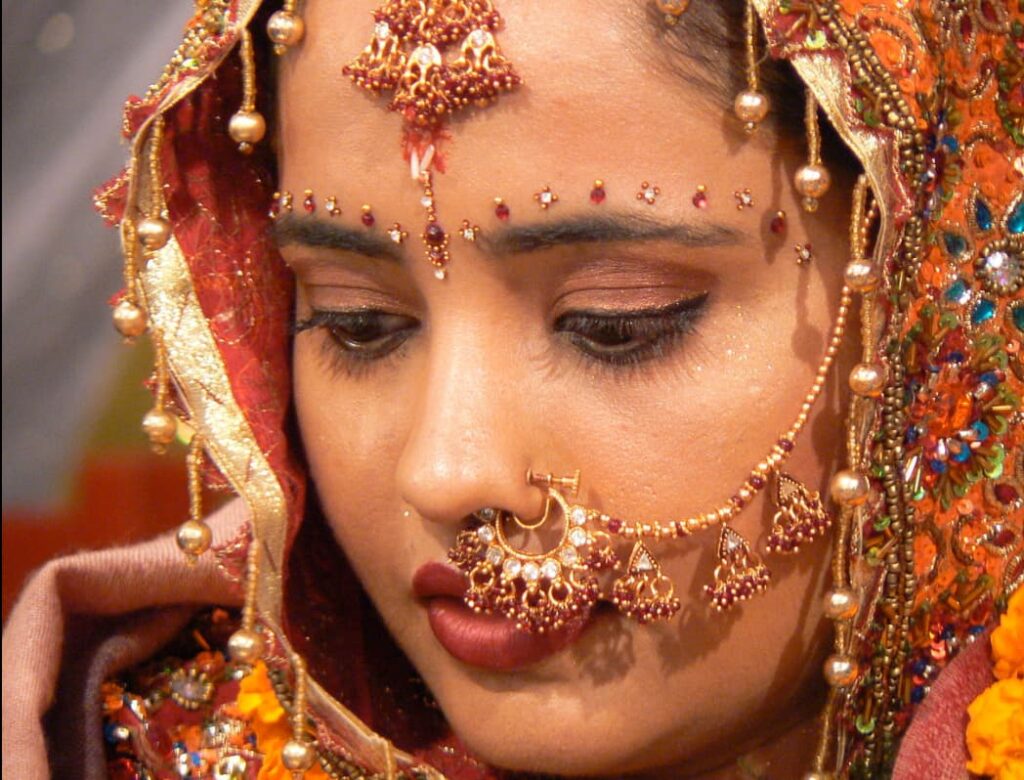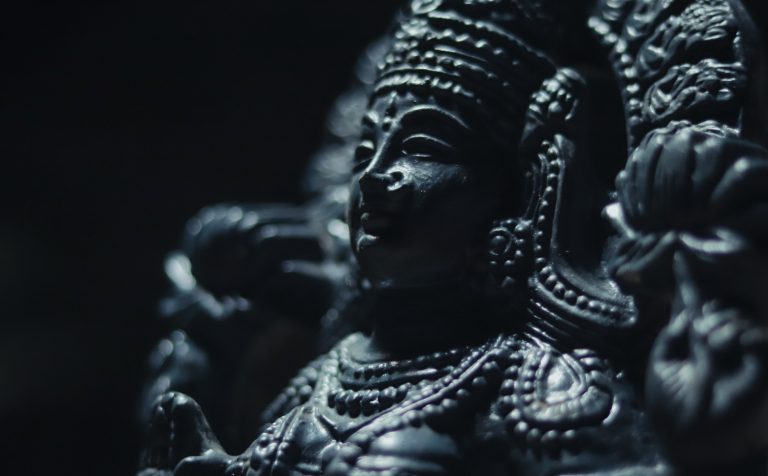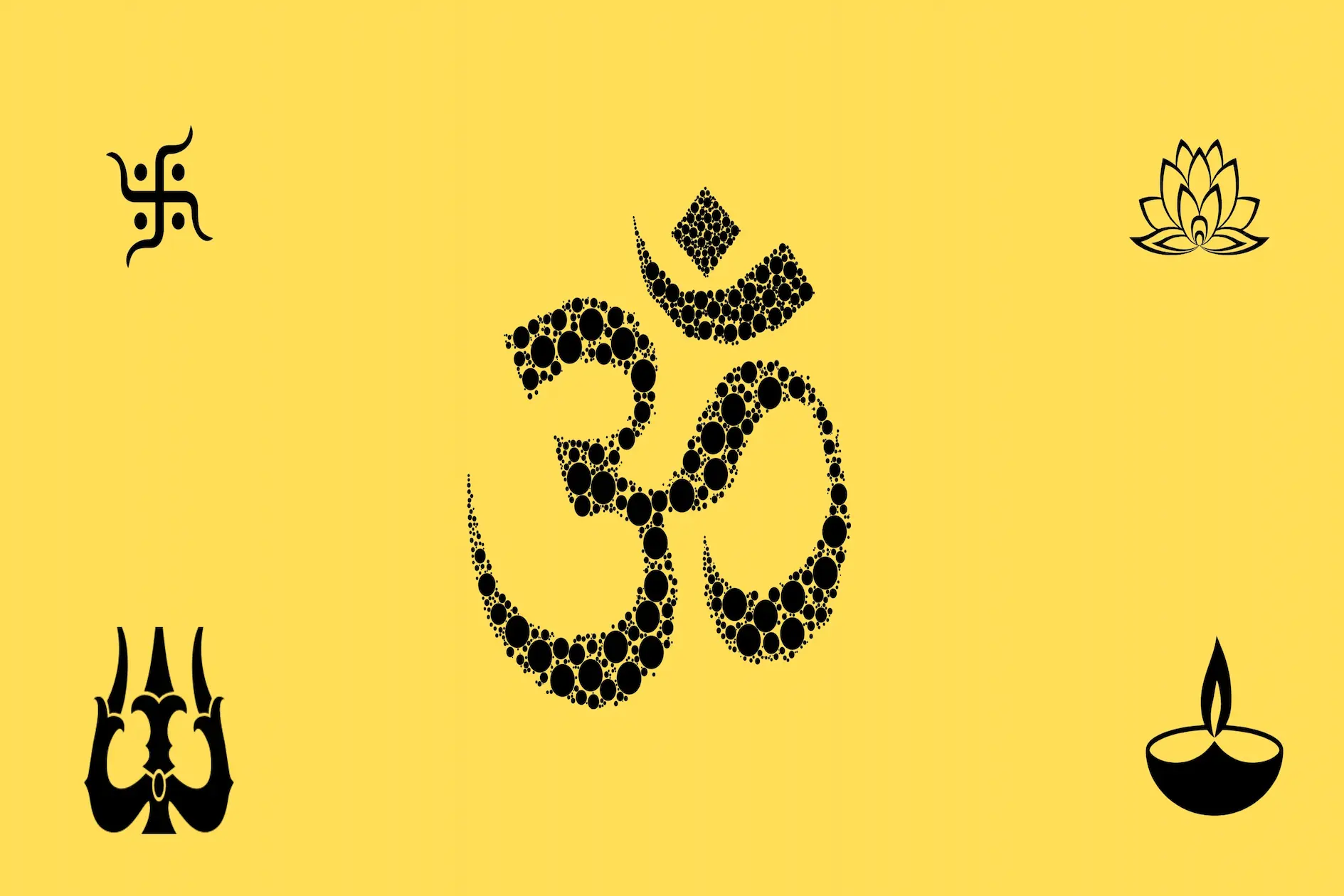The ultimate symbol of a Hindu woman, the Activator of the third eye, pathway to the divine, a Hindu tradition that dates back eons, Bindi’s have always been a deep and firmly rooted aspect of Hinduism. Worn by the rich and poor alike, Bindi boasts a plethora of divine, spiritual and societal benefits, often worn on the foreheads of beautiful and deity-like Hindu women all over the world.

(Public Domain)
What Does the Hindu Red Dot (Bindi) Mean? and why do Indian Hindu Women Wear it?
Bindi (also known as Bindu) is an ancient tradition where a red dot is worn on the center of the forehead, commonly seen among Hindu and some Jain women. Over the years, the Bindi has evolved into one of the key characteristics of Indian tradition and is recognized worldwide.
In addition to being one of the most established Indian traditions, Bindis also serve a greater, auspicious purpose. It is believed that the Bindi is the doorway or “activator” of your third eye, and believed that applying it to your forehead can unlock a plethora of mystical, spiritual, and telepathic powers.
Along with the spiritual power that the Bindi possesses, it is also considered to be the most auspicious symbol of marriage in the Hindu tradition. Married women often wear a red Bindi or “Sindoor” when they get married as it is a common belief that they bring you prosperity and a sense of joy and belonging.
Although Bindi’s carry an intense range of power and ability, they have evolved into a common symbol that is worn by people in all kinds of shapes, sizes, and colors today.
Origin of Bindi
Bindi is deeply rooted in the ancient Vedas and originated from the Sanskrit word “Bindu”, meaning “drop”, “dot”, or “point”, reflecting its round shape. The word “Bindu” is mentioned in the Rigveda as the starting point of creation and the beginning of the universe. This close association with the birth of the universe has earned the Bindi the title of “The sacred symbol of the vast cosmos.
The Bindi is a common sight in the Indian subcontinent and is often seen worn by Hindus in India, Nepal, Sri Lanka, Pakistan, and Bangladesh. It is also worn by women in Southeast Asian countries such as Bali, Malaysia, Singapore, and Vietnam.
Role of Bindi in Hinduism
The Bindi has been a strong symbol in Hinduism for eons, boasting a plethora of uses and purposes- ranging from aesthetic reasons to powerful, spiritual powers. A common sign of Hindu women all over the world, the Bindi’s widely considered to be the “mark” of a Hindu.
Bindi’s and the Ajna Chakra
In Hinduism, it is a common belief that your body consists of seven “chakras” or “energy centers”, which are responsible for various bodily functions and psychic powers. The sixth Chakra- The Ajna Chakra- is located in the center of the forehead. It is believed to act as a “third eye”, on the activation of which your body will be imbibed with psychic powers of telepathy, seeing into the future and achieving true and complete enlightenment.

(Public Domain)
In a bid to concentrate the effects of the Ajna Chakra and strengthen its powers, The Bindi is placed in the Chakra location. It is a common belief that the Bindi can store energy and strengthen concentration, thereby unlocking the Ajna Chakra to its fullest potential. It allows you to reach out to your inner wisdom and knowledge, allowing you to get rid of your ego and perceive the universe around you in its truest form.
In addition to this, the Ajna Chakra is believed to be closely associated with the pineal gland- the part of your body responsible for your sleep cycle and for the psychedelic chemicals that it releases into your body. The Ajna Chakra regulates the function of this gland and hence, is the key to accessing your inner intuition and clarity. The Bindi further enhances this process by strengthening the Ajna Chakra.
Bindi’s and Prayer
Bindi plays a crucial role during religious ceremonies and prayers. Hindus often sit in prayer at the dawn of a new day and worship deities and sing religious hymns in a bid to engage with the divine. After these prayers, you often apply a Bindi to your forehead to lock in their prayers and to be reminded of the auspicious activities that you have performed throughout the day. This is believed to help you achieve your goals and achieve self-actualization and realization. It is a way to forge a link or connection with Brahman (the divine force that governs the Universe).
Bindi’s and Marriage
The Bindi is also considered to be the symbol of love, honor, and prosperity. When a young Hindu woman gets married, she wears a red Bindi or Sindoor as a symbol of her new relationship status. When she crosses over her husband’s house threshold, Bindi is responsible for attracting unbridled prosperity and joy in her new marriage. In addition to this, it also strengthens her bond with her new family and establishes her role in her new house. It is also symbolic of the wife’s desire to prolong the life and health of their husband.

(Public Domain)
However, when a woman is widowed, they are no longer allowed to wear the traditional red Bindi. In such an event, they begin to unravel a smaller, black Bindi- a silent statement to the world about the death of her husband. These Bindi’s signify loss and death and are considered a bad omen for married women.
Bindi also promotes the emotions of understanding and patience, love and joy. Owing to its wide use amongst Hindu women, it is also closely associated with the spirit of womanhood.
Bindi’s and inner-wisdom
Followers also apply the Bindi as a sign of “respect” and “adoration” for their inner Guru. The inner Guru is the part of your Atman (Soul) that possesses a deep knowledge of the Universe and is the harbinger of true enlightenment. Your inner Guru possesses the ability to unlock all seven of your chakras, hence achieving true self-actualization.
Bindi’s and the creation of the universe
In addition to this, the Bindi is considered to be the point at which the universe was created. “The sacred symbol of the cosmos in its unmanifested state”, the Bindi is the point or start around which the Mandala comes into fruition- a physical and diagrammatic representation of the Universe.
Bindi’s and Blood Sacrifice
Bindi’s have been closely associated with the ancient custom of “blood sacrifice”, often done by followers in a bid to appease the Gods. The lack of a Bindi can also be attributed to a death in the family, as women stop wearing Bindi when a death has occurred, hence informing the society that the family is currently in mourning.
Different forms of the Bindi
In addition to differentiating between unmarried, married, and widowed women, Bindi’s were also used to differentiate between the different “castes” or groups of society.
1. The Brahmins (priests, mentors, and those who have achieved supreme knowledge through meditation) were often adorned with a sandalwood-colored Tilak.
2. The Kshatriyas (Warriors, soldiers, fighters) were often adorned with a red color Tilak- a testament to their bravery.
3. The Vaishyas (farmers, traders, merchants, moneylenders) were adorned with a yellow tilak- a symbol of wealth and prosperity.
4. The Sudras (the workers, and laborers) were often spotted with a black tilak, symbolizing their service to society.
What does a Bindi look like and how do you apply it?
The most traditional form of a Bindi is a deep and intense red or maroon color. It is often present in the form of a vermillion powder which you gather on your fingers and place on your forehead. However, over the years, to ease the application process, solid red color discs with a sticky application side came into existence. These Bindis typically consist of a sticky substance on one side and vermilion or Kumkum powder on the other side.
In addition to the traditional Bindi, ornamental Bindis have been worn by women globally for various events and to accentuate their beauty. Rich women in society used to wear ornamental Bindis made of gold. Bindis are also a part of the wedding trousseau and are applied to the forehead during the wedding ceremony and worn thereafter.

(Public Domain)
Significance Of Bindi’s in different parts of India
In addition to the traditional round Bindi worn by Hindus, there exist a variety of different shapes, colors, and sizes, depending upon the state or city that you belong to.
In Maharashtra, the Bindi worn is not round, but rather in the shape of a crescent moon. Larger than the traditional Bindi, it is often accompanied by a small black dot above is- a testament to the “Chandrabindu”- a symbol in Sanskrit script.
In West Bengal, the Bindi is in the form of a large, red dot, much larger than the traditional Bindi. These Bindis are accompanied by decorations on the forehead and the cheeks.
In Rajasthan, a deep red, tilak-shaped, long Bindi is worn. These Bindi’s may be accompanied by a crescent moon.
Finally, in Southern India, a basic, small red bindi is worn, accompanied by a white tilak shape underneath it.
Conclusion
Bindi holds a revered position in Hindu culture as the focal point of creation, the center of the universe, and the embodiment of womanhood. Throughout history and into the future, Hindu women around the world will continue to wear Bindi as a symbol of love, prosperity, relationships, health, and their connection to the divine.





